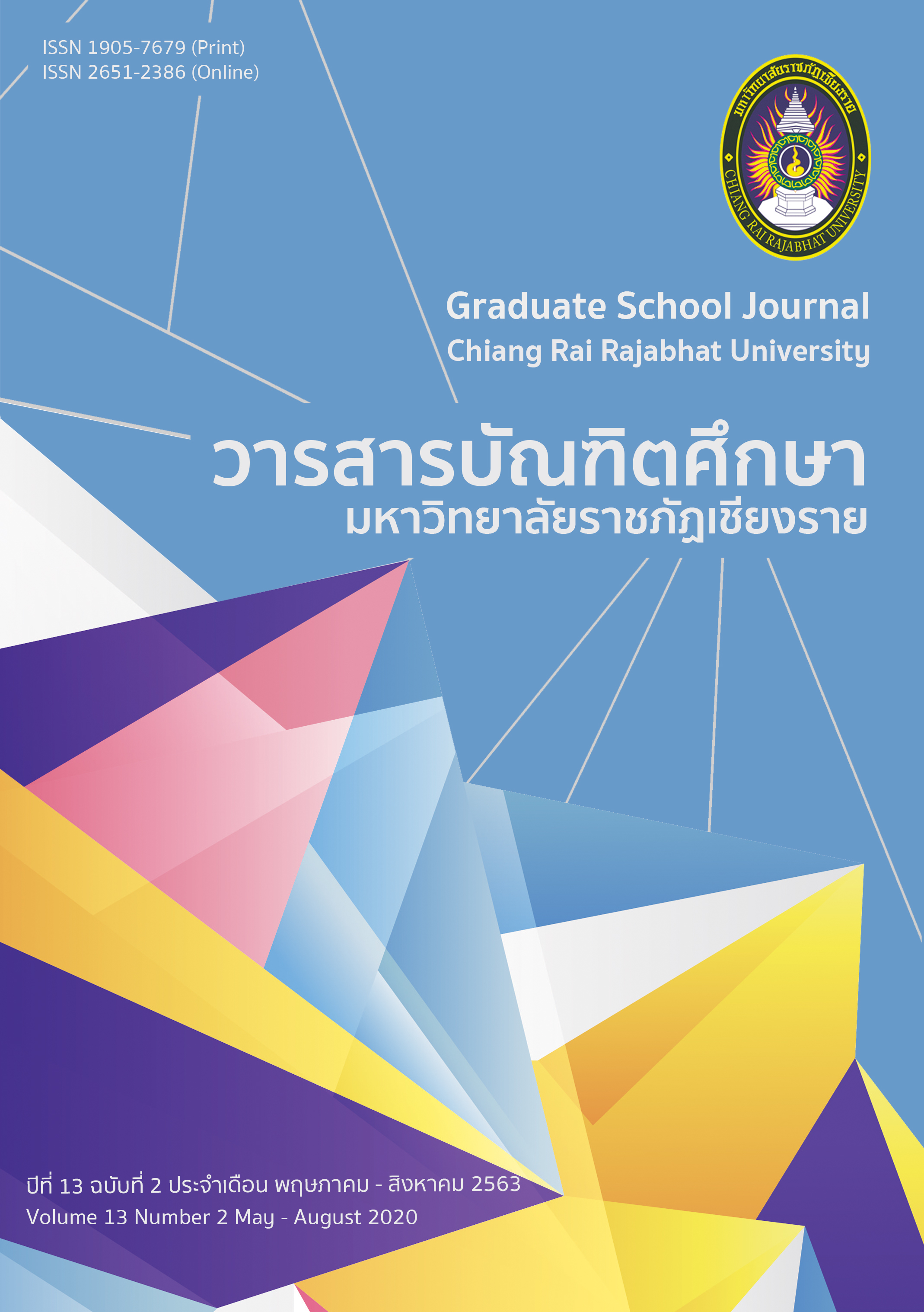การศึกษาเปรียบเทียบสำนวนจีนและสำนวนไทยที่มีคำเกี่ยวกับร่างกาย
Main Article Content
บทคัดย่อ
การวิจัยเรื่อง การศึกษาเปรียบเทียบสำนวนจีนและสำนวนไทยที่มีคำเกี่ยวกับร่างกาย มีวัตถุประสงค์เพื่อศึกษาเปรียบเทียบสํานวนจีนกับสํานวนไทยที่มีคําเกี่ยวกับร่างกาย เพื่อศึกษาคุณค่าภาพสะท้อนทางสังคมและวัฒนธรรมที่มีอยู่ในสำนวนจีนและสำนวนไทย และเพื่อสร้างหนังสือส่งเสริมการอ่าน เรื่อง สำนวนจีนและสำนวนไทยที่มีคำเกี่ยวกับร่างกาย แหล่งข้อมูลที่ใช้ในการวิจัย ได้แก่ พจนานุกรมสำนวนจีน (成语大词典) 100 สำนวนจีน ชุมนุมสำนวนจีน สำนวนสุภาษิตคำพังเพย สำนวนไทยใช้ให้เป็น สำนวนไทยขุนวิจิตรมาตรา และสำนวนไทยฉบับราชบัณฑิตยสถาน พุทธศักราช 2545 ประชากรที่ใช้ในการวิจัย คือ นักศึกษาชาวจีนที่เรียนภาษาไทยในคณะมนุษยศาสตร์ มหาวิทยาลัยราชภัฏเชียงราย ภาคเรียนที่ 2 ปีการศึกษา 2562 จำนวน 20 คน เครื่องมือที่ใช้ในการวิจัย ได้แก่ ตารางสำนวนจีนที่มีคำเกี่ยวกับร่างกาย ตารางสำนวนไทยที่มีคำเกี่ยวกับร่างกาย ตารางสำนวนจีนและสำนวนไทยที่มีคำเกี่ยวกับร่างกายที่มีความหมายเหมือนกัน และแบบประเมินหนังสือส่งเสริมการอ่าน ผลการวิจัย พบว่า
1. ผลการศึกษาเปรียบเทียบสํานวนจีนกับสํานวนไทยที่มีคําเกี่ยวกับร่างกายและมีความหมายเหมือนกัน พบจำนวน 161 สำนวน แบ่งเป็น 3 ประเด็น ได้แก่ 1) สำนวนจีนกับสำนวนไทยที่มีคำเกี่ยวกับร่างกายเหมือนกัน/คล้ายคลึง จำนวน 58 สำนวน 2) สำนวนจีนกับสำนวนไทยที่มีคำเกี่ยวกับร่างกายเหมือนกัน/คล้ายกันบางคำ จำนวน 53 สำนวน และ 3) สำนวนจีนกับสำนวนไทยที่มีคำเกี่ยวกับร่างกายไม่เหมือนกัน จำนวน 50 สำนวน
2. ผลการศึกษาคุณค่าภาพสะท้อนทางสังคมและวัฒนธรรมที่มีอยู่ในสำนวนจีนและสำนวนไทยที่มีคำเกี่ยวกับร่างกาย พบว่า
2.1 คุณค่าของสำนวนจีนกับสำนวนไทยที่มีคำเกี่ยวกับร่างกาย ได้แก่ 1) เป็นหลักคำสอน การตักเตือน ชี้แนะ เรื่องการให้รู้จักเห็นอกเห็นใจผู้อื่น การคิดให้รอบคอบก่อนจะลงมือทำสิ่งใด 2) เป็นเครื่องมือสื่อภาษาเพื่อสื่อสารที่ต้องการให้ผู้ฟังเกิดความรู้สึกและเข้าใจความหมายลึกซึ้ง ทำให้เห็นภาพตามที่ผู้พูดต้องการได้ชัดเจน 3) เป็นเครื่องชี้ให้เห็นความสัมพันธ์ระหว่างคน สัตว์ กับธรรมชาติ และเป็นกระจกสะท้อนภาพสังคม สะท้อนอาชีพ เกษตรกรรม ความคิด ความเชื่อ จารีตประเพณี วิถีชีวิตความเป็นอยู่ การใช้ชีวิตและกฎการลงโทษของคนในสมัยนั้น
2.2 ภาพสะท้อนทางวัฒนธรรม สังคม ในสำนวนจีนกับสำนวนไทยที่มีคำเกี่ยวกับร่างกาย ได้แก่ 1) วัฒนธรรมทางวัตถุ (Material) ประกอบด้วยอาหารการกินและยารักษาโรค เครื่องนุ่งห่ม เครื่องมือ เครื่องใช้และอาวุธ เครื่องดนตรี และธรรมชาติ 2) วัฒนธรรมทางความคิด (Idea) ประกอบด้วยอุปนิสัย/ความคิด ความเชื่อทางศาสนา และเกษตรกรรม 3) วัฒนธรรมด้านบรรทัดฐาน (Norm) ประกอบด้วย การแต่งกาย การพูด และการทำความดี
3. ผลการสร้างหนังสือส่งเสริมการอ่าน เรื่อง สำนวนจีนและสำนวนไทยที่มีคำเกี่ยวกับร่างกาย พบว่ามีความเหมาะสมอยู่ในระดับดี มีค่าเฉลี่ยเท่ากับ 4.25
Article Details
บทความที่ได้รับการตีพิมพ์เป็นลิขสิทธิ์ของวารสารมหาวิทยาลัยราชภัฎเชียงราย
ข้อความที่ปรากฏในบทความแต่ละเรื่องในวารสารวิชาการเล่มนี้เป็นความคิดเห็นส่วนตัวของผู้เขียนแต่ละท่านไม่เกี่ยวข้องกับมหาวิทยาลัยราชภัฎเชียงราย และคณาจารย์ท่านอื่นๆในมหาวิทยาลัยฯ แต่อย่างใด ความรับผิดชอบองค์ประกอบทั้งหมดของบทความแต่ละเรื่องเป็นของผู้เขียนแต่ละท่าน หากมีความผิดพลาดใดๆ ผู้เขียนแต่ละท่านจะรับผิดชอบบทความของตนเองแต่ผู้เดียว
เอกสารอ้างอิง
กณิกนันต์ โยธานะ. (2556). การศึกษาเปรียบเทียบสำนวนจีนที่มีคำว่า “Chi” และ “Shi” กับสำนวนไทยที่มีคำว่า “กิน”. (วิทยานิพนธ์ศิลปศาสตมหาบัณฑิต). จุฬาลงกรณ์มหาวิทยาลัย. กรุงเทพฯ.
จรรยวรรณ เทพศรีเมือง. (2554). ผลการใช้หนังสือเสริมประสบการณ์ด้านวัฒนธรรมไทยสำหรับผู้เรียนภาษาไทยในฐานะภาษาต่างประเทศ. (วิทยานิพนธ์ศึกษาศาสตรมหาบัณฑิต). มหาวิทยาลัยเชียงใหม่. เชียงใหม่.
จินตนา ใบกาซูยี. (2542). เทคนิคการเขียนหนังสือสำหรับเด็ก. กรุงเทพฯ: โรงพิมพ์คุรุสภาลาดพร้าว.
ฉวีวรรณ คูหาภินันท์. (2545). วรรณกรรมสำหรับเด็ก. กรุงเทพฯ: ศิลปาบรรณาคาร.
ดวงใจ ไทยอุบุญ. (2552). ทักษะการเขียนภาษาไทย. กรุงเทพฯ: โรงพิมพ์แห่งจุฬาลงกรณ์มหาวิทยาลัย.
ประยูร ทรงศิลป์. (2553). หลักและการใช้ภาษาไทย. กรุงเทพฯ: เมหาวิทยาลัยราชภัฏธนบุรี.
ภัทรพงศ์ พื้นงาม. (2550). การศึกษาเปรียบเทียบสำนวนจีนและไทยที่สะท้อนภาพสตรี. (วิทยานิพนธ์ศิลปศาสตรมหาบัณฑิต). จุฬาลงกรณ์มหาวิทยาลัย. กรุงเทพฯ.
มหาวิทยาลัยสงขลานครินทร์. คณะวิเทศศึกษา. (2557). รายงานประจําปีการประเมินคุณภาพ. สงขลา: คณะวิเทศศึกษา มหาวิทยาลัยฯ.
ราชบัณฑิตยสถาน. (2556). พจนานุกรมฉบับราชบัณฑิตยสถาน พ.ศ. 2554. กรุงเทพฯ: นานมีบุ๊คพับลิเคชัน.
เรไร ไพรวรรณ์. (2551). วรรณกรรมท้องถิ่น. กรุงเทพฯ: มหาวิทยาลัยราชภัฏธนบุรี.
วิเศษ ชาญประโคน. (2550). ภาษาไทยเพื่อการสื่อสาร. กรุงเทพฯ: ทริปเพิ้ล กรุ๊ป.
วู ถิ กิม จี. (2550). การศึกษาเปรียบเทียบสํานวนเวียดนามกับสํานวนไทย. (ปริญญานิพนธ์ศิลปศาสตรมหาบัณฑิต). มหาวิทยาลัยศรีนครินทรวิโรฒ. กรุงเทพฯ.
สมชาย หองยก. (2550). ภาษาไทยเพื่อการสื่อสาร. กรุงเทพฯ: คณะมนุษยศาสตร์และสังคมศาสตร์ มหาวิทยาลัยราชภัฏวไลยอลงกรณ์ในพระบรมราชูปถัมภ์.
สุปรีดี สุวรรณบูรณ์. (2557). กระบวนการประชาสัมพันธ์. สืบค้นเมื่อ 1 มิถุนายน 2561, จาก http://www.ipesp.ac.th/learning/thai/chapter7-6.html
เหงียน, ทิ ดอง. (2554). สำนวนไทยและสำนวนเวียดนาม : การศึกษาเปรียบเทียบ. (ปริญญานิพนธ์ศิลปศาสตรมหาบัณฑิต). มหาวิทยาลัยนเรศวร. พิษณุโลก.
อริยานุวัตน์ สมาธยกุล. (2559). การประกอบสร้างสำนวนไทยเชิงอำนาจ. (วิทยานิพนธ์ศิลปศาสตรดุษฎีบัณฑิต). มหาวิทยาลัยพะเยา. พะเยา.
อิสริยา คณะเมือง. (2557). การศึกษาเปรียบเทียบสำนวนจีน (4 ตัวอักษร) และสำนวนไทยที่มีความหมายใกล้เคียงกัน. อุบลราชธานี: คณะศิลปศาสตร์ มหาวิทยาลัยอุบลราชธานี.
Ma, Guofan. (1989). Idiom. Inner Mongolia: People’s Publishing House.


